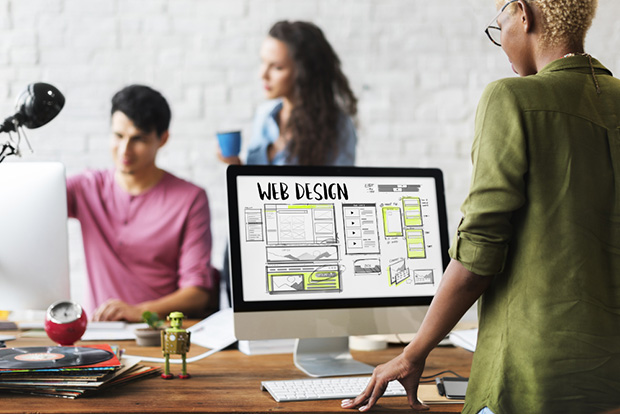Excelling as a Web Designer - Navigating Perspectives, Wellness, and Creativity

Web design is a dynamic field that demands a multifaceted approach to achieve excellence. Beyond technical skills and creativity, success as a web designer involves adopting a holistic perspective that encompasses various angles of work and life.
In this article, we'll explore ways to perform at your best by considering different viewpoints, managing your well-being, and fostering a healthy work-life balance.
Viewing Things from Various Angles:
- a. User-Centric Design:
- b. Adaptability:
- c. Collaboration:
To excel as a web designer, prioritize user-centric design. Understand your audience, empathize with their needs, and create intuitive interfaces. Regularly seek feedback and iterate designs based on user experiences to enhance usability.
Embrace change and stay updated on industry trends. Be willing to learn new tools, programming languages, and design methodologies. A versatile skill set allows you to approach projects from multiple perspectives and deliver innovative solutions.
Work closely with developers, content creators, and other stakeholders. Effective collaboration ensures a more comprehensive understanding of the project, leading to cohesive and well-integrated designs.
Managing Your Mental and Emotional State:
- a. Mindfulness at Work:
- b. Creative Flow:
- c. Feedback and Growth:
Utilize the Rezzimax Pain Tuner Pro II as a tool for mindfulness at work. Incorporate techniques such as deep breathing and short breaks while using the device to enhance focus, alleviate stress, and improve concentration throughout your work hours.
Understand your creative process and recognize when you are most productive. Create a work environment that nurtures creativity, and establish a routine that supports your most productive hours.
Cultivate a growth mindset by actively seeking constructive feedback. View challenges as opportunities for improvement rather than obstacles. Continuous learning fosters a positive work environment and personal development.
Balancing Work and Personal Life:
- a. Setting Boundaries:
- b. Time Management:
- c. Hobbies and Interests:
Establish clear boundaries between work and personal life. Create a dedicated workspace, and define specific working hours. This separation helps prevent burnout and ensures a healthier work-life balance.
Efficiently manage your time by prioritizing tasks and setting realistic deadlines. Utilize project management tools to stay organized and avoid feeling overwhelmed.
Engage in hobbies and activities outside of work to rejuvenate your mind. Pursuing interests unrelated to web design can provide fresh perspectives and fuel creativity.
Enhancing Overall Health and Well-being:
- a. Physical Exercise:
- b. Healthy Eating Habits:
- c. Rest and Sleep:
Incorporate regular physical exercise into your routine. Whether it's a daily walk, gym session, or yoga, exercise boosts both physical and mental well-being.
Pay attention to your diet, ensuring it includes a balance of nutritious foods. Proper nutrition contributes to sustained energy levels and mental clarity.
Prioritize sufficient and quality sleep. Restorative sleep is crucial for cognitive function, creativity, and overall health.
Continuous Professional Development:
- a. Stay Informed:
- b. Attend Conferences and Networking Events:
- c. Portfolio Enhancement:
Keep yourself informed about the latest industry trends, design principles, and emerging technologies. Regularly read design blogs, attend webinars, and participate in online forums to stay connected with the design community.
Attend industry conferences and networking events to meet other professionals, exchange ideas, and gain valuable insights. Building a strong professional network not only opens up opportunities but also provides a support system.
Regularly update your portfolio with your latest and best work. Showcase a diverse range of projects to demonstrate your versatility as a designer. A well-curated portfolio is a powerful tool in attracting new clients or job opportunities.
Embracing Criticism and Iteration:
- a. Constructive Criticism:
- b. Iterative Design Process:
View criticism as a valuable resource for improvement. Embrace feedback, whether it's from colleagues, clients, or users, and use it as a guide for refining your designs. Constructive criticism is a stepping stone to growth and excellence.
Adopt an iterative design process that involves continuous refinement. Rather than aiming for perfection in the first draft, focus on creating a solid foundation and refining your work through multiple iterations. This approach leads to more polished and user-friendly designs.
Cultivating a Passion for Design:
- a. Personal Projects:
- b. Inspiration and Creativity:
- c. Balance Routine and Novelty:
Pursue personal design projects that align with your interests and passions. These projects not only serve as creative outlets but also allow you to experiment with new ideas and techniques that may not be feasible in client projects.
Seek inspiration from various sources, including art, nature, and other design disciplines. Keeping your creativity well filled with diverse influences contributes to a richer and more original design approach.
Find a balance between routine and novelty in your work. While routine ensures consistency and efficiency, introducing novel elements and experimenting with new design trends keeps your work fresh and exciting.
Community Involvement and Mentorship:
- a. Participate in Design Communities:
- b. Mentorship:
Engage with online design communities and forums to share your knowledge, seek advice, and connect with fellow designers. Active participation in these communities fosters a sense of belonging and provides a platform for continuous learning.
Consider both mentoring and being mentored. Mentorship allows you to share your experiences and insights with others, while being mentored provides valuable guidance and different perspectives on your career.
Conclusion:
Success as a web designer extends beyond technical skills. By adopting a holistic approach, considering various perspectives, and prioritizing well-being, you can not only excel in your profession but also lead a fulfilling and balanced life.
Embrace continuous learning, cultivate a positive mindset, and prioritize self-care to achieve lasting success in the ever-evolving world of web design.
Copyright © . All Rights Reserved